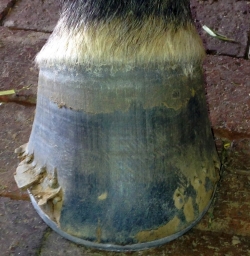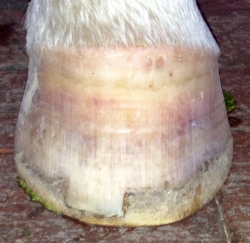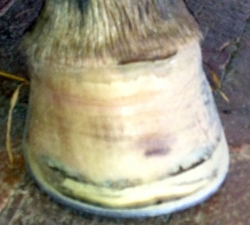The transition that happens when bringing a horse from the track to the farm often requires more intense farrier care than the average farm resident can provide. Clearly, a farrier working at a farm shoeing yearlings or broodmares will not have the same objectives that he or she does when at the track. At the farm your farrier will generally use larger nails, heavier shoes, and a tighter heel fitting. While this is not necessarily ideal, it is highly practical.
The practicality of shoeing a horse this way at the farm correctly implies that a shod racehorse isn’t going to do as well when turned out in a large paddock or field. Smaller (and fewer) nails, light shoes, and full-fitting heels aren’t going to hold up nearly as well when the horse is running full tilt through the mud and then slamming the brakes on a whim.
Fig. 1 shows the effects of this on a racehorse. I would point out that this isn’t the same situation as putting a racehorse in a small paddock for an hour or two per day, and where feet are checked and shoes fixed daily.
Pulling the shoes off can also have consequences. If the horse was recently shod it may become foot sore after removing them so soon and then running around barefoot. Even if that horse has plenty of toe length to work with, the hoof wall is still full of nail holes. A hoof wall full of nail holes will break up fairly quickly in a turnout situation.
 (Photos by the author) Fig. 1: This horse was turned out with shoes on, causing the hoof wall to break away when the horse made sudden stops in the field.
(Photos by the author) Fig. 1: This horse was turned out with shoes on, causing the hoof wall to break away when the horse made sudden stops in the field.
By the way, there is more to do than simply pulling off the shoe. The hoof should be rounded over on the ground surface edges. Fig. 2 shows a foot with nearly all the hoof wall broken away up to the point where the nail patterns would end. Basically all of the porous hoof wall with nail holes in it has broken away. To avoid this, a transitioning horse should be “rounded up” with a horseshoe rasp every two to three weeks while adapting to life on the farm.
A glue-on shoe, shown in Fig. 3, is another choice for keeping a good hoof during turnout, and a possible option for a horse that is in for a little rest and relaxation. This horse started to get in trouble so a glue-on was applied. Your trainer and track farrier are going to be unhappy if they get the horse in Fig. 2 back two weeks before a scheduled race.
An exit strategy from the track and return strategy from the farm will also be helpful. If the farrier knows when a horse is going to the farm, he may change his mind about the timing of a shoeing job. That is, if the race schedule permits. If the farm farrier knows when the horse is going back to a track, the same then applies. One would not take a big trim off a hoof knowing it was going to the track in a week. Communication is the key to a successful transition. If owner, farm manager, trainer and farriers are all on the same page, headaches can be derailed and break-ups avoided.
The practicality of shoeing a horse this way at the farm correctly implies that a shod racehorse isn’t going to do as well when turned out in a large paddock or field. Smaller (and fewer) nails, light shoes, and full-fitting heels aren’t going to hold up nearly as well when the horse is running full tilt through the mud and then slamming the brakes on a whim.
Fig. 1 shows the effects of this on a racehorse. I would point out that this isn’t the same situation as putting a racehorse in a small paddock for an hour or two per day, and where feet are checked and shoes fixed daily.
Pulling the shoes off can also have consequences. If the horse was recently shod, it may become foot sore after having its shoes removed so soon and then running around barefoot. Even if that horse has plenty of toe length to work with, the hoof wall is still full of nail holes. A hoof wall full of nail holes will break up fairly quickly in a turnout situation.


By the way, there is more to do than simply pulling off the shoe. The hoof should be rounded over on the ground surface edges. Fig. 2 shows a foot with nearly all the hoof wall broken away up to the point where the nail patterns would end. Basically all of the porous hoof wall with nail holes in it has broken away. To avoid this, a transitioning horse should be “rounded up” with a horseshoe rasp every two to three weeks while adapting to life on the farm.
A glue-on shoe, shown in Fig. 3, is another choice for keeping a good hoof during turnout, and a possible option for a horse that is in for a little rest and relaxation. This horse started to get in trouble so a glue-on was applied. Your trainer and track farrier are going to be unhappy if they get the horse in Fig. 2 back two weeks before a scheduled race.
An exit strategy from the track and return strategy from the farm will also be helpful. If the farrier knows when a horse is going to the farm, he may change his mind about the timing of a shoeing job. That is, if the race schedule permits. If the farm farrier knows when the horse is going back to a track, the same then applies. One would not take a big trim off a hoof knowing it was going to the track in a week.
Communication is the key to a successful transition. If owner, farm manager, trainer and farriers are all on the same page, headaches can be derailed and break-ups avoided.
Veteran Standardbred farrier Steve Stanley of Lexington, Ky., authors a monthly column for Hoof Beats, the official harness racing publication of the U.S. Trotting Association. The American Farriers Journal Editorial Advisory Board member offers plenty of practical advice that will be of special interest regardless of the type of horses that you work with. Click here to read more from Steve Stanley's Hoof Beats series.








Post a comment
Report Abusive Comment